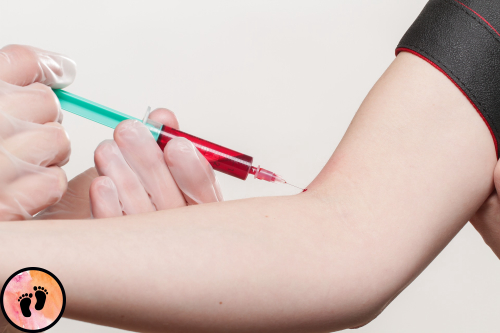Diabetes in Pregnancy Management
OVERVIEW
Pregnancy diabetes is medically termed as “Gestational Diabetes”, is a condition in which a woman develops high blood sugar in the pregnancy, without being diabetic earlier.
 Gestational diabetes is a pregnancy specific diabetes
Gestational diabetes is a pregnancy specific diabetesGestational diabetes prevails in almost 3-9% of the total pregnancies. It is observed that the risk of developing gestational diabetes is 1% under the age of 25 and 13% above 44. This commonly develops in the third trimester of gestation.
Gestational Diabetes, in almost 90% cases, disappears once the baby is born. However, these females are at more risk of getting type 2 diabetes in their future.
Diagnosis of Diabetes
Oral Glucose tolerance tests (OGTT) are generally used to diagnose the diabetes and classify its type.
Test 1:
To rule out gestational diabetes, a two-hour 75g OGTT is used, in which a blood sample is collected after 8 hours of fasting and then is supplemented with an 8-ounce drink that contains 75 g sugar or glucose. Blood samples will then be collected after one and two hours.
Test 2:
If the levels are seen elevated (>140 mg/dl), the second test is used in which the patient is asked to sip 100g sugar syrup and blood sample is collected at one, two and three hours.
 Blood test is utilised for diagnosis of gestational diabetes
Blood test is utilised for diagnosis of gestational diabetesThe table below shows the positive OGTT (Three steps) report for gestational diabetes.
If anyone of the values from the above table turn on the higher side, you will be asked to get the testing done again after 4 weeks. If this continues, you are diagnosed with gestational diabetes.
Types of gestational diabetes
Gestational diabetes is classified into two subtypes:
1. Type A1
Abnormal values of OGTT (Glucose Tolerance Test) but normal sugar values during fasting and two hours after meals.
Change in lifestyle and diet is enough to get into normal values.
2. Type A2
Abnormal OGTT along with abnormal blood glucose levels during fasting and/or after meals.
Medications are required to attain normal values.
Symptoms
Symptoms of gestational diabetes are same as that of diabetes; but generally goes unseen as you may feel a pregnancy symptom.
- More thirst than usual
- More hungry than usual
- More frequent pees
Causes
Whenever you eat, your pancreas releases a hormone which is insulin to move glucose from your blood to cells. The cells utilize this for energy generation.
During pregnancy, enough of sugar builds up in the blood and insulin may not compete with its concentration and you may suffer from high blood sugar.
There are several reasons that put in high blood sugars which are as below:
- Sudden weight gain in pregnancy
- A sedentary lifestyle and being less active
- Expecting multiples
- Have been on glucocorticoids
- Suffers from Polycystic Ovarian Syndrome (PCOS)
- Had gestational diabetes in an earlier pregnancy
- Have a family history of diabetes
- Was prediabetic before conceiving
- Age above 25
- Given birth to an overweight baby in an earlier pregnancy
- Given birth to a baby with some birth defects
Risk of gestational diabetes
Gestational diabetes may risk you as well as your unborn in several ways if left untreated.
- One may suffer from pre-eclampsia that may result in stillbirth or C-sec
- Females with this condition may suffer in delivering vaginally and lead to shoulder dystocia, a condition in which the baby’s shoulder gets caught in the mother’s pelvis
- Woman with high blood sugars may end up with C-section delivery
- Baby born to gestational diabetic mother has higher weight and low sugar levels
- Babies born to mothers with gestational diabetes may have jaundice, high RBC mass, low calcium and magnesium levels.
- The condition may risk the baby for several respiratory distress syndrome
Management
1. Type A1:
In pregnancy, the typical calories requirement is 2000-2500 excluding simple carbs. The diet should be oriented to lower the peak rise in blood sugar levels by proper planning. This can be achieved by taking small carbs meals throughout the day. Insulin resistance is more in the morning, so try to cut all the carbs for breakfast.
- Eat healthy fibre-rich foods
- Cut down sugar
- Regular mild exercises and half an hour walk helps you to keep a check on your weight gain
- Monitor sugar levels regularly
2. Type A2:
The diet management in Type A2 gestational diabetes also remains the same but if cannot be controlled via lifestyle change, one has to take insulin.
Oral Metformin and metformin with insulin are the most widely used medications to treat gestational diabetes.
It is very obvious that you may feel eating well for your baby; but note it’s a myth that you have to eat for two in pregnancy.
Eating healthy is what the baby needs to fulfil all its essentials. Keep a check on what you eat, be active and enjoy the hassle-free pregnancy.
Happy Pregnancy..!
References

Recent Posts
Homemade Pregnancy Test
How to Prevent Pregnancy Stretch Marks
Is It Safe to Eat Ice Cream During Pregnancy
Breast Pain in Pregnancy
7 Tips to getting pregnant faster
COMMON INFECTIONS DURING PREGNANCY
Pregnancy Diet: Apples during Pregnancy
Advertisement
Duis leo. Donec orci lectus, aliquam ut, faucibus non
Join Our Community of Expecting Parents Today!
Subscribe to get updated on latest and relevant pregnancy-related details